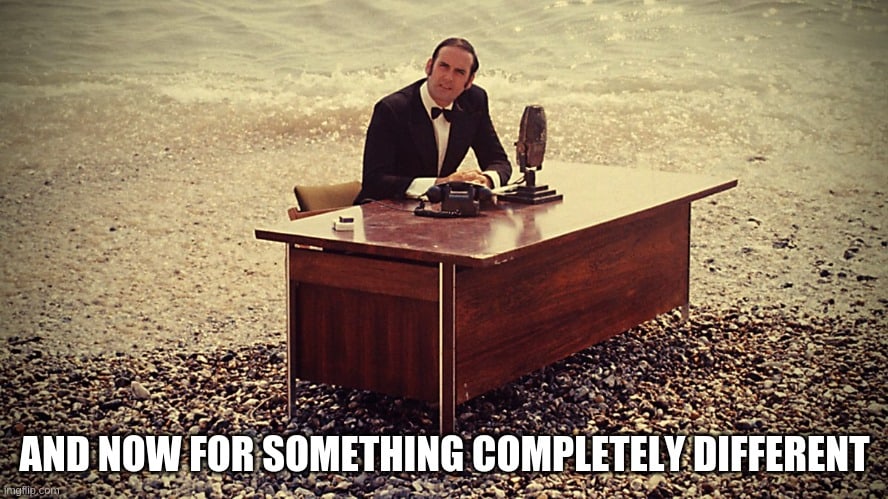In these trying times…
In these uncertain times…
As we navigate the new normal…
As you know, many people are struggling…
We’ve now reached peak COVID-19 I think. Why every company thinks they need to send me a super special email detailing what they’re doing “in these trying times” is beyond me. I certainly don’t want to subject you all to a similar display, so instead let’s dive into something completely different!

Synchronous vs Asynchronous Communication
For those of you who haven’t completed a Telecommunications degree first we need to define a couple of terms. Basically when we talk about synchronous or asynchronous communication we mean whether or not they’re occurring in sync.
So an example of a synchronous communication is talking on the phone or in person. Normally you’d respond to the person in real time, back and forth. An example of asynchronous communication is where you don’t have to respond in real time like in a chat app or via email.
You’ll send an SMS or Signal message and the other person might not reply to it for 5 minutes, an hour or even a week. After using both forms of communication for decades now I thought it was time I had a bit of a look into which ones works the best and is most efficient from a getting work done perspective.
After much investigation it became clear the answer is pretty straight forward: Asynchronous communication wins hands down.
Asynchronous Is More Efficient
The two main reasons asynchronous communications wins is that
- It enables you to work without having your flow interrupted
- You can do it with multiple people at once, even while working
Flow is a general term used to describe that mode you get into where you become essentially super productive. There’s been many books and articles written about it but basically it’s when you’re just super focused on a task, time melts away, you forget everything else and yeet that task out in an insane amount of time. You’re productivity goes bonkers and the thing you’re doing gets done super fast.
Matt D’Avella covers it in more detail in the above video but one of the key components of getting into and staying in a “flow state” is to not be distracted. You cannot be super productive if every 5 minutes someone calls you on the phone and you’re forced to pick it up and answer them.
Not only does it obviously take time away from the task you’re doing but there is also a considerable amount of time that’s required to then get back into that same flow state again – if you can at all.
With asynchronous forms of communication like SMS, WhatsApp, Signal, Email, Slack etc the expectation isn’t there that you will answer immediately. Sure, different people put different expectations on different forms of communications but overall I think most people are happy for someone to reply to an email/WhatsApp etc in 2 hours. As a result, you can put everything on DND (do not disturb) and ensure your flow state doesn’t get interrupted.
Conversely everyone expects the person they’re calling on the phone to pick it up and devote all their attention to them when they call.
Multitasking Goes Up
This brings us into our second reason why asynchronous communication is better, you can talk to multiple people and do multiple things all at once further increasing productivity.
When you’re on the phone or in a meeting it’s generally considered rude to not give the other person/people your complete, undivided attention. This means you can’t do anything else. Maybe you can quickly check your phone and respond to an email or two but any more than that and it’s not the best signal to give off, especially at work.
Contrast this with chatting and you can easily have five separate apps/windows open all at the same time talking to many happy people. This could even be while you’re collaborating on a group document or doing something else.
This multitasking obviously means you can’t really get into a more efficient flow state, but you’re still able to at least do work on and off. Some other benefits of asynchronous communication is that it allows you time to formulate a more nuanced response.
Not everyone can think on their feet perfectly every time so having even 2-3 minutes to write something, delete a bit, fix up a part of it, tone it down a bit or Google something to support your argument can be invaluable. At work this can even potentially save your job if you’re angry or super frustrated at the time.
If you’re in a meeting and pissed off, it’s likely you might say something you regret. If you’re communicating via email though you can write it out then wait until tomorrow to send it. I know plenty of times I’ve asked someone to review an email or two and heavily changed it as I tend to be very blunt and it can come off as sounding mean.
Finally asynchronous communication can greatly increase productivity if you have the same message to tell multiple people. CC’ing a dozen people in an email can save a huge amount of time, but I don’t think I’d go the route scooter company Bird did when they fired 400 staff via a single Zoom call…
Synchronous Communication Has Its Moments

Asynchronous communication isn’t perfect though. I believe it’s the best default form of communicate for work – and most other – situations but sometimes, for specific reasons there’s just no beating picking up a phone or seeing someone in person.
When you’re trying to solve a complex (or often emotional) problem with another person speaking over the phone or in person communicates more to the other person that gets missed via things like chat apps.
Most communication is actually done through non-verbal means so these apps miss the huge array of other information that gets sent out. Body language, tonality, volume etc all make communicating more efficient and effective.
So if you’re trying to convey how sorry you are, how happy you are or just in general most emotions, in person or at worst over the phone is likely best. Obviously if you’re needing an immediate reply phoning is also best.
Beyond these two general use cases I find that the more I can push my communications to asynchronous, the more efficient it is for everyone involved. As an additional side effect, I also find there ends up being more communication as a result of using asynchronous. This is because smashing out a quick chat message at the time you want to say something is easier than trying to organise an in person meeting.
So how do you handle communication for work or business? Do you always use the phone? Do you loath email? Or has Slack made your life 100x easier? Let us know in the comments below!
The benefits include: 1) How to get those silky smooth videos that everyone loves to watch, even if you're new 2) How to fly your drone, from taking off to the most advanced flight modes 3) Clear outlines of how to fly with step-by-step instructional demonstrations and more 4) Why flying indoors often results in new pilots crashing their drone 5) What other great 3rd party apps are out there to get the most out of your drone 6) A huge mistake many pilots make when storing their drone in the car and how to avoid it 7) How to do all of these things whilst flying safely and within your countries laws.




